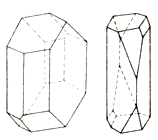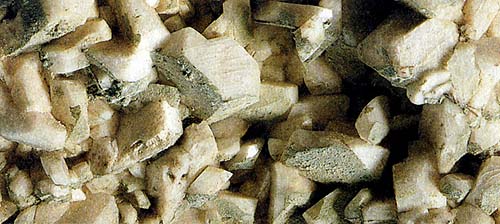Feldspars (silicates): Albit
 Diagnostic card.
Diagnostic card.
In the photo - beautiful pinkish crystals of albite from the province of Quebec (Canada). Below: a periclin, a kind of albite.
Na Al Si 3 O 8
Triclinic syngene
Hardness 6-6,5
Specific gravity
Cleavage is easily manifested
Cracked shell
Color is colorless, differently colored
Color in powder white
Glitter glass

 From the lat. Albus is a white, mineral of the feldspar group. The shape of the crystals. Columnar, needle, tabular, twinned crystals, polysynthetic twins. Crystal structure. Frame lattice with a continuous three-dimensional skeleton. Class of symmetry. Pinacoid - 1. Cleavage. Perfect in the basis (P), the mean of the lateral finite faces (M) and the faces of the prism (T). Aggregates. Dense, granular, radiant.
From the lat. Albus is a white, mineral of the feldspar group. The shape of the crystals. Columnar, needle, tabular, twinned crystals, polysynthetic twins. Crystal structure. Frame lattice with a continuous three-dimensional skeleton. Class of symmetry. Pinacoid - 1. Cleavage. Perfect in the basis (P), the mean of the lateral finite faces (M) and the faces of the prism (T). Aggregates. Dense, granular, radiant.
Albit crystals are almost always twinned by different rules, which partly coincide with those indicated for orthoclase, but are partly typical for albite.
In the latter case, the crystals come into contact along a common surface, which forms incoming corners in the crystals. If the individuals joining in during the twinning process are more than two, there is a so-called polysynthetic twinning - then on the crystals there is a hatching caused by this phenomenon. The habitus of albite crystals varies from tabular to prismatic. Albit - the mineral is very solid, colorless and transparent, sometimes white and opaque, sometimes translucent; Has a glass luster.
Diagnostic signs.
Of all acids, only fluoride decomposes this mineral to form a jelly-like residue of silica. It melts with difficulty, it stains the flame yellow due to the presence of sodium. Melts with difficulty, gives a yellow sodium flame. Behavior in acids. Slightly soluble.
Origin.
Mineral is common and widespread, albite is found in igneous rocks, both intrusive and effusive, is also present in metamorphic rocks.
Place of Birth.
Beautiful crystal druses meet in Courmere, in the Monte Bianco zone, in Valle d'Aosta. Excellent specimens, sometimes in the right intergrowths with orthoclase, are known in the granites of Baveno, on Lake Lago-Major. In Piemonte, in Val Vigezzo, large veins (sometimes developed) are widespread, in which microscopic but most interesting and rare minerals are represented. In the cracks among the rocks of the Alps there is often a periclin, a kind of albite, especially common in Val di Vizza and Val Aurina, near Bolzano.
Application.
In deposits where the albite is presented in sufficient quantities, it is extracted as raw material for the production of ceramics and refractory materials. Ceramic raw materials.

Stryuverit (dark), albite (cleavelandite). Volodarsk-Volyn Pegatite Field, Ukraine. Photo: © А.А. Evseev.


Voginite in albite. Elash, to Yu from Tayshet, Sown, Wed. Siberia (Y). Shibanovskiy mn, Primorye, Russia. Photo: © А.А. Evseev.
- Ghetchellit - "New Almaden blend" - arsenide and antimony sulfide (modern sulfosol)
- Antimony is a toxic metal (semimetal) , widely used in metallurgy, medicine and engineering
- Zirconium - a rare and undiscovered metal and the most dangerous precious stone in oxide and salt
- Gold - yellow dangerous and poisonous metal of modern accurate digital and cable technologies
- Sulfur is a golden-yellow toxic substance and a sign of active volcanic activity
- Cadmium is an undisputed toxic silvery metal unknown to a wide range of people
- Lead - a toxic gray imitator of metallic silver and toxic metal blende
- Arsenic is a classic poison of medieval and modern poisoners and medicine in medicine
Poisonous and radioactive dangerous stones and minerals
** - poisonous stones and minerals (mandatory check in the chemical laboratory + explicit indication of toxicity)
** - radioactive stones and minerals (mandatory check on the standard dosimeter + ban on open sales in case of radioactivity exceeding 24 milli / g / h + additional measures of population protection)
Catalog of minerals and semi-precious stones of the world by groups
** - poisonous stones and minerals
** - radioactive stones and minerals


Comments
When commenting on, remember that the content and tone of your message can hurt the feelings of real people, show respect and tolerance to your interlocutors even if you do not share their opinion, your behavior in the conditions of freedom of expression and anonymity provided by the Internet, changes Not only virtual, but also the real world. All comments are hidden from the index, spam is controlled.